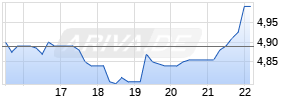
Unisys Announces 2Q FY18 Results; Services Revenue and Backlog Grow Year-Over-Year, and Total Operating Profit Margin Expands; Company Reaffirms Full-Year Financial Guidance
PR Newswire
BLUE BELL, Pa., July 31, 2018
BLUE BELL, Pa., July 31, 2018 /PRNewswire/ --
2Q 2018:
- Total revenue of $667 million reflects Services revenue growth of 2.1 percent year-over-year
- The company achieved operating profit margin of 8.1 percent, up 860 basis points year-over-year and non-GAAP operating profit(6) margin of 8.3 percent, up 440 basis points year-over-year
- Net income was $4 million versus a loss of $42 million in the prior-year period; Adjusted EBITDA grew 46 percent year-over-year to $99 million
- Total Contract Value(1) ("TCV") grew 70 percent year-over-year in the quarter and 120 percent for the first half; new business TCV rose 102 percent year-over-year in the quarter and 126 percent in the first half
- Services backlog(4) was up 27 percent year-over-year to $4.6 billion
- Diluted earnings per share was $0.07 versus a diluted loss per share of $0.83 in the prior-year period; non-GAAP diluted earnings per share was $0.39 versus $0.06 in the prior-year period
Unisys Corporation (NYSE: UIS) today reported second-quarter 2018 financial results. Total company revenue of $667 million reflects Services revenue growth of 2.1 percent year-over-year. Operating profit margin was 8.1 percent, up 860 basis points year-over-year. Non-GAAP operating profit margin expanded to 8.3 percent, up 440 basis points year-over-year.
The company reported strong contract signings with Total Contract Value (or "TCV") up 70 percent year-over-year for the quarter and 120 percent for the first half. New business TCV was up 102 percent in the quarter and 126 percent in the first half. Services backlog was up 27 percent year-over-year to $4.6 billion.
"We are pleased to see solid revenue performance, with our third consecutive quarter of year-over-year growth, margin expansion for the company overall and improvements within our Services business, which saw revenue grow more than 2 percent year-over-year," said Unisys Chairman, President and CEO Peter A. Altabef. "Our strong second quarter results indicate continued progression toward our goals for 2018."
Summary of Second-Quarter 2018 Business Results
Company:
Revenue of $667 million reflected growth in Services revenue of 2.1 percent year-over-year (total revenue was down 1.2 percent on a constant-currency(3) basis).
Operating profit margin was 8.1 percent, up 860 basis points year-over-year. Non-GAAP operating profit margin was 8.3 percent, an increase of 440 basis points year-over-year.
Net income for the second quarter was $3.8 million, versus a net loss of $42.0 million in the second quarter of 2017. Diluted earnings per share was $0.07, versus a diluted loss per share of $0.83 in the second quarter of 2017. Non-GAAP diluted earnings per share(10) was $0.39 versus $0.06 in the prior-year period.
Adjusted EBITDA(9) for the second quarter grew 46.4 percent year-over-year to $99.0 million. Adjusted EBITDA margin for the second quarter expanded by 470 basis points year-over-year to 14.8 percent.
Second quarter cash used in operations was $11.7 million versus $49.2 million used in operations in the second quarter 2017. Second quarter adjusted free cash flow(12) was $(4.6) million, versus $(43.5) million in the second quarter of 2017. At June 30, 2018, the company had $584 million in cash and cash equivalents.
TCV grew 70 percent year over year, and new business TCV grew 102 percent. On a cumulative basis for the first half of 2018, TCV was up 120 percent year over year, with new business TCV up 126 percent year-over-year.
The company reaffirms full-year 2018 guidance for non-GAAP adjusted revenue of $2.7-2.825 billion (GAAP revenue of $2.75-2.875 billion), non-GAAP operating profit margin of 7.75-8.75 percent (GAAP operating profit margin of 9.5-10.5 percent) and adjusted EBITDA margin of 13.7-14.9 percent.
Services:
Services revenue grew 2.1 percent year-over-year (or 0.4 percent in constant-currency) to $587 million, which represented 88 percent of total second-quarter revenue. Services backlog grew 27 percent year-over-year to end the second quarter at $4.6 billion. Services gross profit margin was up 240 basis points year-over-year, to 16.5 percent, and Services operating profit margin was up 480 basis points year-over-year to 3.2 percent. Services SG&A was helped in part by the gain on the sale of a property in the UK.
Technology:
Technology revenue in the second quarter was roughly in line with company expectations due to the timing of the ClearPath Forward® renewal schedule at $81 million, down 11.7 percent year-over-year as reported (11.3 percent in constant currency). Technology revenue represented 12 percent of total second-quarter revenue. Technology gross profit margin for the second quarter was up 830 basis points year-over-year to 67.1 percent. Technology operating profit margin was up 960 basis points year-over-year to 45.1 percent. The improvements to Technology margins were driven in part by a higher mix of software revenue in the quarter.
Key Second-Quarter Contract Signings:
In the second quarter, the company entered into several key contracts in each of its sectors including the following:
- U.S. Federal: During the second quarter, we successfully implemented a Stealth™ solution for a U.S. federal national security agency to provide enhanced biometric identity management capabilities for an international collaboration partner. Unisys' Stealth® solution was chosen due to its scalable architecture, allowing for the use of dozens of biometric capture systems to be integrated with existing law enforcement, national security and other government credentialing systems.
- Public: Unisys was awarded a contract by the State of Georgia, a new logo, to provide hybrid cloud services in support of the Georgia Enterprise Technology Services program. This program provides reliable, secure and innovative IT infrastructure services to Georgia state and local government agencies.
- Commercial: A large Australian private health provider signed a contract for Unisys to provide a Managed Security Information and Event Management (SIEM) system. The solution includes technology from Unisys partner LogRhythm, a leader in security intelligence and analytics. The Unisys solution will allow the organization to secure its environment by quickly and efficiently detecting and neutralizing advanced cyber threats before they can disrupt operations. A Unisys Security Operations Centre will manage the SIEM and provide 24/7 detection and response services.
- Financial Services: A leading U.S. financial services holding company signed an agreement with Unisys for a range of infrastructure and IT services, including deskside support, service desk, data center and network management designed to improve the efficiency of their day-to-day operations and service management expertise. It was Unisys' largest financial services contract of the quarter.
Conference Call
Unisys will hold a conference call today at 5:30 p.m. Eastern Time to discuss its results. The listen-only webcast, as well as the accompanying presentation materials, can be accessed on the Unisys Investor website at www.unisys.com/investor. Following the call, an audio replay of the webcast, and accompanying presentation materials, can be accessed through the same link.
(1) Total Contract Value – TCV is the estimated total contractual revenue related to contracts signed in the period including option years (Federal contracts only) and without regard for cancellation terms. New business TCV represents TCV attributable to new scope for existing clients and new logo contracts.
(2) Annual Contract Value – ACV represents the revenue expected to be recognized during the first twelve months following the signing of a contract in the period.
(3) Constant currency – The company refers to growth rates in constant currency or on a constant currency basis so that the business results can be viewed without the impact of fluctuations in foreign currency exchange rates to facilitate comparisons of the company's business performance from one period to another. Constant currency is calculated by retranslating current and prior period results at a consistent rate.
(4) Services Backlog – Services Backlog is the balance of contracted services revenue not yet recognized, including only the funded portion of services contracts with the U.S. Federal government.
Non-GAAP and Other Information
Although appropriate under generally accepted accounting principles ("GAAP"), the company's results reflect revenue and charges that the company believes are not indicative of its ongoing operations and that can make its revenue, profitability and liquidity results difficult to compare to prior periods, anticipated future periods, or to its competitors' results. These items consist of certain portions of revenue, post-retirement and cost-reduction and other expense. Management believes each of these items can distort the visibility of trends associated with the company's ongoing performance. Management also believes that the evaluation of the company's financial performance can be enhanced by use of supplemental presentation of its results that exclude the impact of these items in order to enhance consistency and comparativeness with prior or future period results. The following measures are often provided and utilized by the company's management, analysts, and investors to enhance comparability of year-over-year results, as well as to compare results to other companies in our industry.
(5) Non-GAAP adjusted revenue – For the first half of 2018, the company's non-GAAP results include an adjustment to exclude certain revenue. The company has excluded revenue of $53 million. This is revenue from software license extensions and renewals which were contracted for in the fourth quarter of 2017 and properly recorded as revenue at that time under the revenue recognition rules then in effect (ASC 605). Upon adoption of the new revenue recognition rules (ASC 606) on January 1, 2018, and since the company adopted ASC 606 under the modified retrospective method whereby prior periods were not restated, the company was required to include this $53 million in the cumulative effect adjustment to retained earnings on January 1, 2018. ASC 606 requires revenue related to software license renewals or extensions to be recorded when the new license term begins, which in the case of the $53 million is January 1, 2018. The company has excluded revenue and related profit for these software licenses in its non-GAAP results since it has been previously reported in 2017. This is a one-time adjustment and it will not reoccur in future periods. However, in its quarterly financial statements on Form 10-Q for all of 2018, the company is required to report what its financial statements would have been if it had not adopted ASC 606. The $53 million is included in those adjustments. There are additional adjustments being made, but they do not represent previously recorded revenue. Those adjustments represent other differences between ASC 605 and ASC 606, principally extended payment term software licenses and short-term software licenses both of which are recorded at the inception of the license term under ASC 606 but were required to be recognized ratably over the software license term under ASC 605.
(6) Non-GAAP operating profit - The company recorded pretax post-retirement expense and pretax charges in connection with cost-reduction activities and other expenses. For the company, non-GAAP operating profit excluded these items. The company believes that this profitability measure is more indicative of the company's operating results and aligns those results to the company's external guidance which is used by the company's management to allocate resources and may be used by analysts and investors to gauge the company's ongoing performance. In the first half of 2018, the company included the ASC 606 adjustment discussed in (5) above.
(7) Non-GAAP adjusted Technology gross profit margin – In the first half of 2018, the company included the ASC 606 adjustment discussed in (5) above.
(8) Non-GAAP adjusted Technology operating profit margin – In the first half of 2018, the company included the ASC 606 adjustment discussed in (5) above.
(9) EBITDA & adjusted EBITDA – Earnings before interest, taxes, depreciation and amortization ("EBITDA") is calculated by starting with net income (loss) attributable to Unisys Corporation common shareholders and adding or subtracting the following items: net income attributable to noncontrolling interests, interest expense (net of interest income), provision for income taxes, depreciation and amortization. Adjusted EBITDA further excludes post-retirement expense, cost-reduction and other expense, non-cash share-based expense, and other (income) expense adjustment. In order to provide investors with additional understanding of the company's operating results, these charges are excluded from the adjusted EBITDA calculation. In the first half of 2018, the company included the ASC 606 adjustment discussed in (5) above.
(10) Non-GAAP diluted earnings per share - The company has recorded post-retirement expense and charges in connection with cost-reduction activities and other expenses. Management believes that investors may have a better understanding of the company's performance and return to shareholders by excluding these charges from the GAAP diluted earnings/loss per share calculations. The tax amounts presented for these items for the calculation of non-GAAP diluted earnings per share include the current and deferred tax expense and benefits recognized under GAAP for these amounts. In the first half of 2018, the company included the ASC 606 adjustment discussed in (5) above.
(11) Free cash flow - The company defines free cash flow as cash flow from operations less capital expenditures. Management believes this liquidity measure gives investors an additional perspective on cash flow from on-going operating activities in excess of amounts used for reinvestment.
(12) Adjusted free cash flow - Because inclusion of the company's post-retirement contributions and cost-reduction and other payments in free cash flow may distort the visibility of the company's ability to generate cash flow from its operations without the impact of these non-operational costs, management believes that investors may be interested in adjusted free cash flow, which provides free cash flow before these payments. This liquidity measure was provided to analysts and investors in the form of external guidance and is used by management to measure operating liquidity.
About Unisys
Unisys is a global information technology company that builds high-performance, security-centric solutions for the most demanding businesses and governments on Earth. Unisys offerings include security software and services; digital transformation and workplace services; industry applications and services; and innovative software operating environments for high-intensity enterprise computing. For more information on how Unisys builds better outcomes securely for its clients across the Government, Financial Services and Commercial markets, visit www.unisys.com.
Forward-Looking Statements
Any statements contained in this release that are not historical facts are forward-looking statements as defined in the Private Securities Litigation Reform Act of 1995. Forward-looking statements include, but are not limited to, any projections of earnings, revenues, annual contract value, total contract value, new business ACV or TCV, backlog or other financial items; any statements of the company's plans, strategies or objectives for future operations; statements regarding future economic conditions or performance; and any statements of belief or expectation. All forward-looking statements rely on assumptions and are subject to various risks and uncertainties that could cause actual results to differ materially from expectations. In particular, statements concerning annual and total contract value are based, in part, on the assumption that all options of the contracts (Federal only) included in the calculation of such value will be exercised and that each of those contracts will continue for their full contracted term. Risks and uncertainties that could affect the company's future results include, but are not limited to, the following: our ability to improve revenue and margins in our services business; our ability to maintain our installed base and sell new solutions in our technology business; our ability to effectively anticipate and respond to volatility and rapid technological innovation in our industry; our ability to retain significant clients; the potential adverse effects of aggressive competition in the information services and technology marketplace; cybersecurity breaches could result in significant costs and could harm our business and reputation; our significant pension obligations and required cash contributions and requirements to make additional significant cash contributions to our defined benefit pension plans; our ability to attract, motivate and retain experienced and knowledgeable personnel in key positions; the risks of doing business internationally when a significant portion of our revenue is derived from international operations; our contracts may not be as profitable as expected or provide the expected level of revenues; our ability to access financing markets; contracts with U.S. governmental agencies may subject us to audits, criminal penalties, sanctions and other expenses and fines; a significant disruption in our IT systems could adversely affect our business and reputation; we may face damage to our reputation or legal liability if our clients are not satisfied with our services or products; the performance and capabilities of third parties with whom we have commercial relationships; an involuntary termination of the company's U.S. qualified defined benefit pension plan; the potential for intellectual property infringement claims to be asserted against us or our clients; the business and financial risk in implementing future acquisitions or dispositions; the adverse effects of global economic conditions, acts of war, terrorism or natural disasters; the possibility that pending litigation could affect our results of operations or cash flow; and the company's consideration of all available information following the end of the quarter and before the filing of the Form 10-Q and the possible impact of this subsequent event information on its financial statements for the reporting period. Additional discussion of factors that could affect the company's future results is contained in its periodic filings with the Securities and Exchange Commission. The company assumes no obligation to update any forward-looking statements.
RELEASE NO.: 0731/9606
Unisys and other Unisys products and services mentioned herein, as well as their respective logos, are trademarks or registered trademarks of Unisys Corporation. Any other brand or product referenced herein is acknowledged to be a trademark or registered trademark of its respective holder.
UIS – Q
| UNISYS CORPORATION | | |||||||||
| CONSOLIDATED STATEMENTS OF INCOME | | |||||||||
| (Unaudited) | | |||||||||
| (Millions, except per share data) | | |||||||||
| | | | | | | | ||||
| | | Three Months Ended | | | Six Months Ended | | ||||
| | | 2018 | | 2017 | | | 2018 | | 2017 | |
| Revenue | | | | | | | | | | |
| Services | | $ 586.7 | | $ 574.8 | | | $ 1,155.2 | | $ 1,160.1 | |
| Technology | | 80.7 | | 91.4 | | | 220.6 | | 170.6 | |
| | | 667.4 | | 666.2 | | | 1,375.8 | | 1,330.7 | |
| Costs and expenses | | | | | | | | | | |
| Cost of revenue: | | | | | | | | | | |
| Services | | 484.2 | | 510.8 | * | | 955.1 | | 997.2 | * |
| Technology | | 30.3 | | 36.7 | * | | 66.6 | | 76.2 | * |
| | | 514.5 | | 547.5 | * | | 1,021.7 | | 1,073.4 | * |
| Selling, general and administrative | | 92.7 | | 111.4 | * | | 183.6 | | 216.4 | * Werbung Mehr Nachrichten zur Unisys Aktie kostenlos abonnieren
E-Mail-Adresse
Bitte überprüfe deine die E-Mail-Adresse.
Benachrichtigungen von ARIVA.DE (Mit der Bestellung akzeptierst du die Datenschutzhinweise) -1  Vielen Dank, dass du dich für unseren Newsletter angemeldet hast. Du erhältst in Kürze eine E-Mail mit einem Aktivierungslink. Hinweis: ARIVA.DE veröffentlicht in dieser Rubrik Analysen, Kolumnen und Nachrichten aus verschiedenen Quellen. Die ARIVA.DE AG ist nicht verantwortlich für Inhalte, die erkennbar von Dritten in den „News“-Bereich dieser Webseite eingestellt worden sind, und macht sich diese nicht zu Eigen. Diese Inhalte sind insbesondere durch eine entsprechende „von“-Kennzeichnung unterhalb der Artikelüberschrift und/oder durch den Link „Um den vollständigen Artikel zu lesen, klicken Sie bitte hier.“ erkennbar; verantwortlich für diese Inhalte ist allein der genannte Dritte. Andere Nutzer interessierten sich auch für folgende News |




